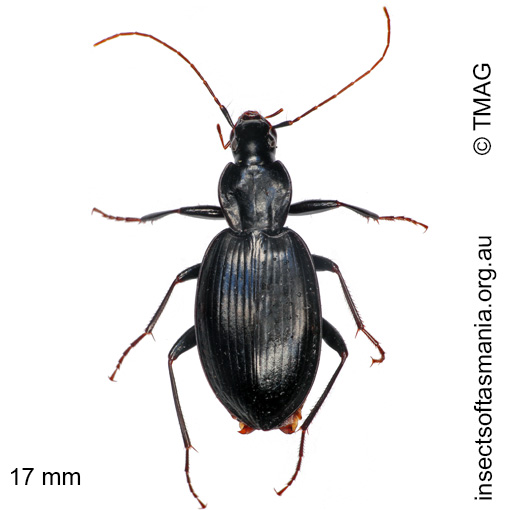
Lestignathus cursor
Basis for Tasmanian occurrence
TMAG collections
Classification
Suborder: Adephaga
Superfamily: Caraboidea
Family: Carabidae
Subfamily: Harpalinae
Tribe: Licinini
Morphology
Flightedness: functionally flightless
Source literature on morphology and taxonomy (*primary taxonomic source, where identified):
Baehr, M. (2000). A new species of the genus Lestignathus Erichson from Tasmania with a note on the Tasmanian species of Mecyclothorax Sharp…. Rec. S. Aust. Mus. 33 (2): 123-126.
*Erichson, W.F. (1842). Beitrag zur Insecten-Fauna von Vandiemensland, mit besonderer Beruecksichtung der geographischen Verbreitung der Insecten. Nicolai’schen Buchhandlung 8(1): 379 pages.
Sloane, T.G. (1920). The Carabidae of Tasmania. Proc. Linn. Soc. NSW 45: 113-178.
Ecology
Association with dead wood or old trees: (not yet documented)
Ecological attributes: — Affiliated with mature (unlogged) forest (Michaels, 1999) — Forest generalist (Grove, 2009).
Collection method(s) for TMAG material: — Pitfall trapping.
Source ecological literature:
Baker, S.C. (2000). Forest litter beetles and their habitat: a comparison of forest regenerated by wildfire and logging practices. Hons. thesis, Univ. of Tasmania, Hobart.
Baker, S.C. (2006b). Ecology and conservation of ground-dwelling beetles in managed wet eucalypt forest: edge and riparian effects. PhD thesis, Univ. of Tasmania, Hobart.
Driscoll, D. A. (1010). Few beetle species can be detected with 95% confidence using pitfall traps. Aust. Ecol. 35: 13-23.
Grove, S.J. & Yaxley, B. (2005). Wildlife habitat strips and native forest ground-active beetle assemblages in plantation nodes in northeast Tasmania. Aust. J. Entom. 44 (4): 331-343.
Grove, S.J. (2009c). Do wildlife habitat strips act as refuges for mature-forest carabid beetle assemblages? A case-study in Tasmanian wet eucalypt forest, Australia. For. Ecol. Manage. 259: 496-504.
Michaels, K.F. & McQuillan, P.B. (1995). Impact of commercial forest management on geophilous Carabid beetles (Coleoptera; Carabidae) in tall, wet Eucalyptus obliqua forest in southern Tasmania. Aust. J. Ecol. 20: 316-323.
Michaels, K.F. (1999a). Carabid beetles as biodiversity and ecological indicators. PhD thesis, Univ. of Tasmania, Hobart.
Taylor, R.J. et al. (2000). Occurrence of old-growth carabid beetles in retained unlogged strips in … southern Tasmania. In: Saunders, D. et al. . (Eds.), Nature Conservation 5…. Surrey Beatty, pp. 120-127.

